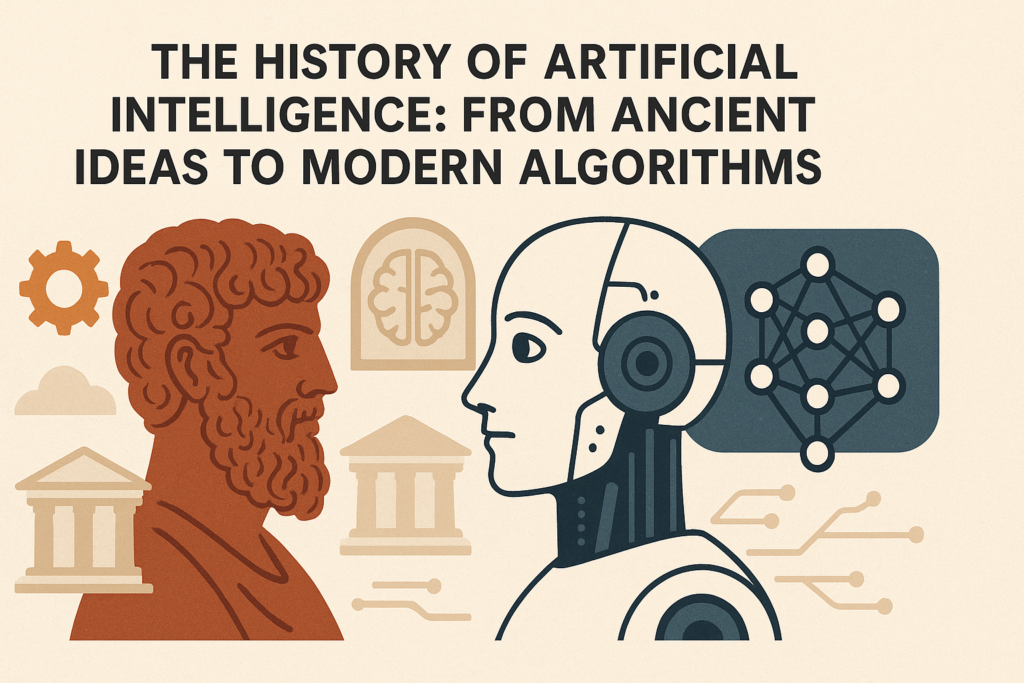Contents
- How AI Is Changing Everyday Life in 2025
- AI at Home: The Rise of Smart Living
- Transportation: Autonomous and AI-Optimized Mobility
- Healthcare: Predictive, Preventive, and Personalized
- Work and Productivity: AI as a Collaborative Partner
- Education: Learning Becomes Personalized and Interactive
- Retail and Shopping: Hyper-Personalization and Automation
- Communication and Social Interaction
- Finance: Smarter Decisions and Safer Transactions
- Entertainment: AI-Curated and Generated Content
- Ethics, Privacy, and Governance in 2025
- What’s Next? The Road Ahead
- Conclusion
How AI Is Changing Everyday Life in 2025
Artificial Intelligence (AI) has evolved from a futuristic concept into an integral part of our daily lives. In 2025, AI will no longer be just a buzzword—it’s a transformative force that touches nearly every facet of society. From the way we work and communicate to how we learn, shop, travel, and even manage our health, AI is reshaping the human experience with remarkable speed and sophistication.
In this blog, we explore how AI is changing everyday life in 2025, highlighting real-world applications, industry shifts, ethical considerations, and what lies ahead.
Learn More:- AI vs Human Creativity
AI at Home: The Rise of Smart Living
The modern home in 2025 is a hub of interconnected devices powered by AI. From intelligent climate control systems to adaptive lighting and smart kitchen appliances, homes now learn from residents’ habits and optimize comfort, efficiency, and security.
Voice Assistants with Emotional Intelligence
Voice-activated assistants such as Alexa, Google Assistant, and Apple’s Siri have undergone significant upgrades. In 2025, these AI assistants will not only respond to commands but also interpret emotions through voice tone, facial recognition, and contextual behavior. This emotional intelligence enables more empathetic and contextually relevant interactions. For example, if you’re stressed, your assistant might play calming music, adjust the lighting, or suggest a break.
AI-Driven Home Security
Home security systems now employ AI-powered surveillance with facial recognition, anomaly detection, and predictive behavior analysis. These systems can differentiate between routine events and potential threats, alerting homeowners and authorities in real time while reducing false alarms.
Read More:- Neural Networks NL
Transportation: Autonomous and AI-Optimized Mobility
Transportation is one of the most visibly transformed sectors in 2025, driven by AI innovation.
Self-Driving Cars at Scale
While fully autonomous vehicles are not yet universal, many cities have deployed AI-driven shuttles, taxis, and delivery vehicles in geofenced areas. Tesla, Waymo, and other mobility players have launched Level 4 autonomous vehicles capable of handling most driving tasks with minimal human oversight.
AI in vehicles isn’t limited to navigation. AI now predicts maintenance needs, optimizes energy usage in electric vehicles (EVs), and even customizes in-car experiences based on user profiles, adjusting music, seat positions, and climate control automatically.
AI-Powered Traffic Systems
Smart cities use AI to manage traffic flow, reduce congestion, and decrease emissions. These systems analyze traffic in real-time and adapt signal patterns, suggest alternate routes, and prioritize emergency vehicles dynamically. In places like Singapore and Dubai, these systems are contributing to smoother urban mobility.
Healthcare: Predictive, Preventive, and Personalized
AI is revolutionizing healthcare in 2025 through early diagnosis, personalized treatment, and improved patient engagement.
AI in Diagnostics and Imaging
AI-powered diagnostic tools now outperform human radiologists in detecting conditions like cancer, fractures, and cardiovascular diseases. Tools like Google’s DeepMind and IBM Watson Health (reimagined under new partnerships) are analyzing vast medical datasets to provide second opinions and uncover patterns previously invisible to clinicians.
Virtual Health Assistants
Telehealth platforms have integrated virtual AI assistants that triage symptoms, schedule appointments, and offer real-time medical advice. These assistants, trained on vast datasets, are accessible 24/7, democratizing healthcare access and reducing pressure on medical professionals.
Personalized Treatment Plans
AI algorithms analyze genetic data, lifestyle inputs, and electronic health records to tailor treatments for individual patients. This move from a “one-size-fits-all” model to precision medicine is improving outcomes in chronic disease management, oncology, and mental health.
Work and Productivity: AI as a Collaborative Partner
AI is not replacing jobs as rapidly as once feared—instead, it’s augmenting human capabilities.
Intelligent Workflows
From project management tools like Asana and Monday.com to document processing in Microsoft 365 and Google Workspace, AI is embedded into daily workflows. It automatically drafts emails, summarizes meetings, prioritizes tasks, and even flags potential errors in documents.
Recruitment and HR Automation
AI is transforming how companies recruit and retain talent. Platforms use AI to screen resumes, match candidates with roles, and reduce bias in hiring. Predictive analytics helps HR teams understand employee engagement, attrition risks, and productivity trends.
Creative Collaboration
AI tools like ChatGPT, DALL·E, and Adobe Firefly assist content creators by generating text, images, videos, and designs. Rather than replacing human creativity, these tools act as collaborators, accelerating ideation and execution.
Education: Learning Becomes Personalized and Interactive
The education sector in 2025 embraces AI to deliver customized, engaging, and equitable learning experiences.
Adaptive Learning Platforms
Platforms like Khan Academy, Coursera, and Duolingo use AI to adjust content based on learner performance, preferences, and pace. AI tutors provide real-time support, while dashboards give educators insights into student progress.
AI-Enhanced Classrooms
In physical and virtual classrooms, AI monitors engagement, tracks attention spans, and suggests intervention strategies. Teachers receive actionable feedback to personalize instruction and identify struggling students early.
Lifelong Learning with AI Mentors
AI mentors now guide learners through career development, suggesting courses, certifications, and skill upgrades based on job market trends and individual aspirations.
Learn More:- Machine Learning (ML)
Retail and Shopping: Hyper-Personalization and Automation
Retail is increasingly AI-driven, delivering seamless, personalized, and predictive shopping experiences.
Personalized Recommendations
E-commerce platforms leverage AI to analyze user behavior, preferences, and purchase history to deliver hyper-targeted recommendations. Platforms like Amazon, Shopify, and TikTok Shop have created “AI storefronts” that adapt in real time to each visitor.
Smart Stores
Brick-and-mortar retail isn’t dead—it’s evolving. Stores use computer vision and sensor technology to offer cashier-less checkouts, like Amazon Go. AI-driven inventory systems optimize stock management and reduce waste.
Virtual Try-Ons and Styling
AI enables shoppers to virtually try on clothes, makeup, and accessories via augmented reality (AR). Apps suggest outfits based on body type, current trends, and personal style, enhancing the online shopping experience.
Communication and Social Interaction
AI is reshaping how we connect, both online and in person.
Real-Time Language Translation
Tools like Google Translate and Meta’s AI models now offer real-time voice translation in dozens of languages with near-human accuracy, breaking down language barriers in global communication.
AI Avatars and Digital Humans
In social platforms and virtual meetings, AI avatars represent users, mimicking voice, facial expressions, and gestures. In business, AI-generated digital twins act as brand ambassadors, support agents, or trainers.
Moderation and Safety
AI systems now play a major role in content moderation, identifying harmful content, misinformation, and online harassment with higher precision. While not perfect, they enable safer online spaces across social platforms.
Finance: Smarter Decisions and Safer Transactions
AI has become central to how we manage money, from personal finance to corporate banking.
AI Financial Advisors
Robo-advisors like Betterment and Wealthfront have become more sophisticated, offering tailored investment strategies, risk analysis, and real-time portfolio optimization. AI tracks market trends and adjusts portfolios proactively.
Fraud Detection and Risk Management
AI-powered systems detect unusual transaction patterns and alert users instantly, helping prevent fraud and identity theft. Banks use predictive models to assess creditworthiness and personalize financial products.
Conversational Banking
Customers now interact with AI chatbots for banking services—checking balances, transferring funds, or disputing charges—with high accuracy and natural language comprehension.
Learn More:- Deep Learning
Entertainment: AI-Curated and Generated Content
Entertainment is undergoing a renaissance powered by AI creativity.
Content Generation
AI tools help produce music, screenplays, books, and animations. Platforms like Suno for music or Runway for video editing enable creators to bring ideas to life with minimal technical barriers.
Personalized Streaming
Netflix, Spotify, and YouTube now use deep learning to understand not just what you like, but how you’re likely to feel at a given time, recommending content that aligns with your emotional state, schedule, or even weather.
Interactive Experiences
AI is enabling immersive storytelling in games and VR environments. Non-player characters (NPCs) now exhibit dynamic behavior, adapt to player actions, and respond with human-like dialogue generated in real-time.
Read More:- The History of Artificial Intelligence
Ethics, Privacy, and Governance in 2025
With AI’s growing presence comes deeper questions about data use, privacy, and societal impact.
Data Ownership and Consent
Legislation around AI and data privacy, such as the Global AI Ethics Framework and regional laws modeled on the GDPR, now emphasizes user rights, transparency, and explainability. Users are empowered to control how their data is collected and used by AI systems.
Bias and Fairness
AI systems are under scrutiny for fairness. Developers are increasingly accountable for algorithmic bias. Organizations now employ “ethics by design” practices, auditing models for discriminatory behavior, and ensuring diversity in datasets.
Regulation and Oversight
Governments and international bodies have established AI oversight committees to assess risk, promote innovation, and establish compliance standards. While the pace of regulation varies by country, global consensus is growing around safe AI development and deployment.
What’s Next? The Road Ahead
As we move deeper into 2025 and beyond, the trajectory of AI suggests even more profound integration into society. Quantum computing, brain-computer interfaces, and generalized AI (AGI) are on the horizon, promising to elevate machine capabilities further.
However, the future of AI will depend not just on technology but on the values and policies we embed into its design. Collaboration between governments, private enterprises, and civil society will be essential to ensure that AI remains a force for good, enhancing, rather than diminishing, the human experience.
Conclusion
In 2025, AI is no longer science fiction. It’s part of our homes, our work, our schools, our hospitals, and our cities. It enhances convenience, drives efficiency, and unlocks new possibilities. But with these advancements come new responsibilities—to ensure ethical use, protect privacy, and foster inclusive development.
AI is not just changing how we live—it’s redefining what’s possible. As we stand on the threshold of even greater innovation, one thing is clear: AI will continue to shape everyday life in ways we are only beginning to imagine.



